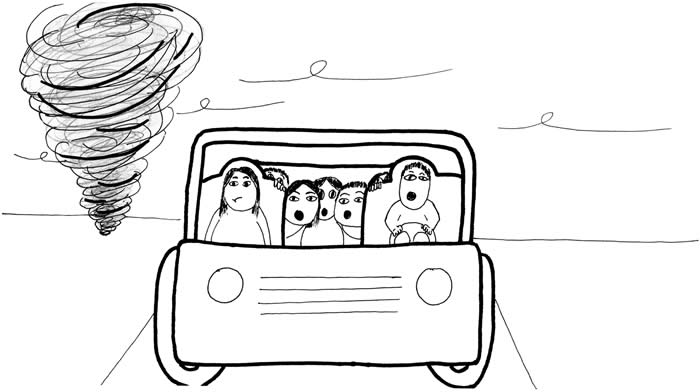

2018/2019
On the Way Home1933; Upland, Nebraska, USA
Imagine driving along the road and seeing a black tornado-shaped storm headed straight for you and your family. What would you say? What would you do? My great-grandma and her family had to figure out what to do — and fast! It was the 1930s, the time of the Great Depression. My great-grandma Jean was eight years old and lived on a farm near Upland, Nebraska, with her three sisters and two brothers. They lived in the Dust Bowl,1 where tornado-shaped clouds of dust often formed because the vegetation was lost and the soil was reduced to dust and eroded. Dust storms caused a lot of damage to a lot of people, like my great-grandma Jean and her family. Even though life on the farm was hard, family was still important. One calm summer morning in 1933, Jean and her family got into the farm truck to go to an aunt and uncle’s anniversary party many miles away. Jean’s mama left the windows to the house open to air the house out, just as she did every other summer day. Later that day, Jean was celebrating with family and friends when they saw the black tornado picking up dust from the ground and spinning it around into a storm. Jean and her family immediately got back into the truck to go home. The wind was blowing so fast that dust was swooping off the ground and running over fences like snow. Cars were being covered in dust. Very quickly, Jean’s family knew they could not drive on in this storm, so they stopped at a farmhouse off the road. No one was home, but the door was unlocked so they went in. They knew the house was welcoming because of the beautiful cake on the table. Of course, all the kids wanted a slice, but Mama said no. Later that evening, they realized they couldn’t get back out on the road and would have to stay the night. They begged Mama enough that she finally let each kid have one slice of cake, but then they had to go to bed. Mama knew she would make the family a cake to replace the one they ate. The next morning the dust had settled, and the family made it the rest of the way home. When they got inside their little farmhouse, everything was covered in dust. The windowsills had an inch of dust on them, the stick of butter on the countertop looked like a stick of mud, and the floors and furniture were hidden under a thick layer of black powder. Once everything was cleaned up, Mama and the kids made a cake for the friendly people whose house they had stayed at that night. My great-grandma Jean and her family may not have made it home that night, but they realized that night that families could get through anything as long as they stayed together. Cami Kohmetscher; Missouri, USA Illustrator: Eva Stern; Missouri, USA
1. “The Dust Bowl” usually refers to an area of the central United States that had a lot of dust storms in the 1930s.
This copyrighted story may be copied and/or printed for limited classroom or personal use. To reprint this story in an article about The Grannie Annie, please contact The Grannie Annie Family Story Celebration for permission.
Return to Vol. 14 Stories page
|
Built by Hen's Teeth Network